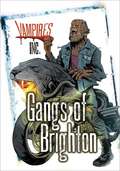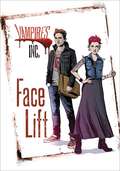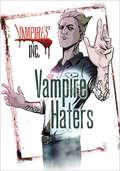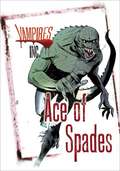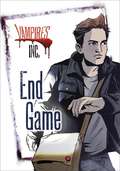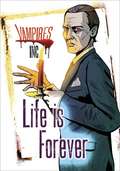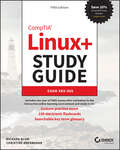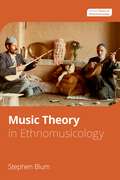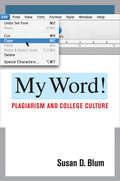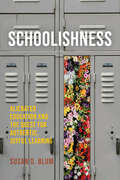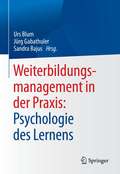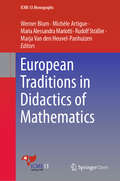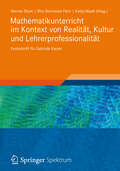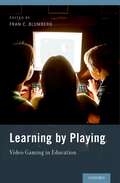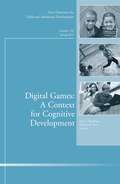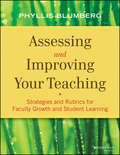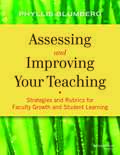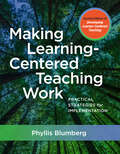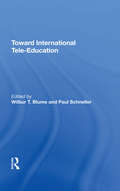- Table View
- List View
Vampires Inc: Gangs of Brighton (PDF)
by Paul BlumThere's trouble brewing in Brighton when a gang of werewolf bikers come to town. The Lukos Chapter are on a mission to track down one particular vampire. And he just happens to be Rose Petal s new boyfriend ... The new Vampires Inc. stories offer page-turning, achievable reads for learners who may struggle with full-length fiction but want to engage with this genre. With pacey narrative and plenty of dialogue, the series will capture the imagination of the most reluctant reader.nbsp;
Vampires Inc: Face Lift (PDF)
by Paul BlumJohn Logan is a successful author, researching his second book on vampires. John has been approached by Rose Petal to be his research assistant. Rose lives in Brighton and knows a lot more about what goes on after dark in this seaside city than John can ever imagine.
Vampires Inc: Vampire Haters (PDF)
by Paul BlumIts Halloween and not everyone is in a party mood. An escaped convict has a deadly grudge against Brighton s vampires. Who will be the next victim of this vampire hater? The new Vampires Inc. stories offer page-turning, achievable reads for learners who may struggle with full-length fiction but want to engage with this genre. With pacey narrative and plenty of dialogue, the series will capture the imagination of the most reluctant reader.nbsp;
Vampires Inc: Ace of Spades (PDF)
by Paul BlumJohn Logan is going undercover to help solve a murder. The chief suspect is a well-known gangster, but his henchmen are a different species altogether. In this game, the odds of John making it through the night are slim ... The new Vampires Inc. stories offer page-turning, achievable reads for learners who may struggle with full-length fiction but want to engage with this genre. With pacey narrative and plenty of dialogue, the series will capture the imagination of the most reluctant reader.nbsp;
Vampires Inc: End Game (PDF)
by Paul BlumFear is spreading through Brighton's supernatural community. Every night more vampires go missing. When John and Rose finally get a lead on the mysterious Ace of Spades project, they need back-up from two dangerous enemies to stop the war that is brewing.
Vampires Inc: Life is Forever (PDF)
by Paul BlumA haunted church, a missing teacher and a dead student lead John Logan and Rose Petal to a man with a dark secret. Joseph Judd certainly isn t what he seems, but what exactly is he? The new Vampires Inc. stories offer page-turning, achievable reads for learners who may struggle with full-length fiction but want to engage with this genre. With pacey narrative and plenty of dialogue, the series will capture the imagination of the most reluctant reader.
CompTIA Linux+ Study Guide: Exam XK0-005 (Sybex Study Guide)
by Richard Blum Christine BresnahanThe best-selling, hands-on roadmap to acing the new Linux+ exam In the newly updated Fifth Edition of CompTIA Linux+ Study Guide: Exam XK0-005, IT industry veterans and tech education gurus Richard Blum and Christine Bresnahan deliver a concise and practical blueprint to success on the CompTIA Linux+ exam and in your first role as a Linux network or system administrator. In the book, you’ll find concrete strategies and proven techniques to master Linux system management, security, scripting, containers, automation, and troubleshooting. Every competency tested on the Linux+ exam is discussed here. You’ll also get: Hands-on Linux advice that ensures you’re job-ready on the first day of your new network or sysadmin role Test-taking tips and tactics that decrease exam anxiety and get you ready for the challenging Linux+ exam Complimentary access to the Sybex learning environment, complete with online test bank, bonus practice exams, electronic flashcards, and a searchable glossary Perfect for practicing network and system admins seeking an in-demand and valuable credential for working with Linux servers and computers, CompTIA Linux+ Study Guide: Exam XK0-005, Fifth Edition, will also earn a place in the libraries of people looking to change careers and start down an exciting new path in tech. And save 10% when you purchase your CompTIA exam voucher with our exclusive WILEY10 coupon code.
CompTIA Linux+ Study Guide: Exam XK0-005 (Sybex Study Guide)
by Richard Blum Christine BresnahanThe best-selling, hands-on roadmap to acing the new Linux+ exam In the newly updated Fifth Edition of CompTIA Linux+ Study Guide: Exam XK0-005, IT industry veterans and tech education gurus Richard Blum and Christine Bresnahan deliver a concise and practical blueprint to success on the CompTIA Linux+ exam and in your first role as a Linux network or system administrator. In the book, you’ll find concrete strategies and proven techniques to master Linux system management, security, scripting, containers, automation, and troubleshooting. Every competency tested on the Linux+ exam is discussed here. You’ll also get: Hands-on Linux advice that ensures you’re job-ready on the first day of your new network or sysadmin role Test-taking tips and tactics that decrease exam anxiety and get you ready for the challenging Linux+ exam Complimentary access to the Sybex learning environment, complete with online test bank, bonus practice exams, electronic flashcards, and a searchable glossary Perfect for practicing network and system admins seeking an in-demand and valuable credential for working with Linux servers and computers, CompTIA Linux+ Study Guide: Exam XK0-005, Fifth Edition, will also earn a place in the libraries of people looking to change careers and start down an exciting new path in tech. And save 10% when you purchase your CompTIA exam voucher with our exclusive WILEY10 coupon code.
Kindesvertretung: Konkret, partizipativ, transdisziplinär (Gesellschaft der Unterschiede #74)
by Stefan Blum Sabine Brunner Peter Grossniklaus Christophe A. Herzig Barbara Jeltsch-Schudel Susanne MeierGute Kindesvertretung hat zum Ziel, die Partizipation von Kindern, die in ein juristisches Verfahren involviert sind, zu ermöglichen und mitzugestalten. Die Autor*innen des Bandes stellen diesen Prozess erstmals transdisziplinär dar - als Synthese juristischer, psychologischer, (behinderten-)pädagogischer und sozialarbeiterischer Theorie und Praxis. Sie zeichnen die Lage der Kindesvertretung in den deutschsprachigen Ländern nach und entwickeln Standards für alle Phasen der Vertretung, konkretisiert anhand von Fallbeispielen aus der Schweiz. Dabei kommen nicht nur Fachpersonen und Entscheidungsträger*innen zu Wort, sondern auch betroffene Kinder und Jugendliche.
Music Theory in Ethnomusicology (Oxford Theory in Ethnomusicology)
by Stephen BlumDuring the 1960s and 70s some ethnomusicologists formed relationships with music-makers and ritual specialists in an attempt to interpret how they understood their musical actions. Subsequently ethnomusicologists have studied the respects in which explicit and implicit theory is involved in communication of musical knowledge. They have observed the production of music theory in institutions of modern nation-states and have sought out groups and individuals whose theorizing is not constrained by existing institutions. They are assessing the extent to which musical terminologies of diverse languages can be interpreted in relation to general concepts without imposing the assumptions and biases of one body of existing theory. That exercise is increasingly recognized as a necessary effort of decolonization. A thorough yet concise introduction to this field, Music Theory in Ethnomusicology outlines a conception of music theory suited to cross-cultural research on musical practices.
Music Theory in Ethnomusicology (Oxford Theory in Ethnomusicology)
by Stephen BlumDuring the 1960s and 70s some ethnomusicologists formed relationships with music-makers and ritual specialists in an attempt to interpret how they understood their musical actions. Subsequently ethnomusicologists have studied the respects in which explicit and implicit theory is involved in communication of musical knowledge. They have observed the production of music theory in institutions of modern nation-states and have sought out groups and individuals whose theorizing is not constrained by existing institutions. They are assessing the extent to which musical terminologies of diverse languages can be interpreted in relation to general concepts without imposing the assumptions and biases of one body of existing theory. That exercise is increasingly recognized as a necessary effort of decolonization. A thorough yet concise introduction to this field, Music Theory in Ethnomusicology outlines a conception of music theory suited to cross-cultural research on musical practices.
My Word!: Plagiarism and College Culture
by Susan D. Blum"Classroom Cheats Turn to Computers." "Student Essays on Internet Offer Challenge to Teachers." "Faking the Grade." Headlines such as these have been blaring the alarming news of an epidemic of plagiarism and cheating in American colleges: more than 75 percent of students admit to having cheated; 68 percent admit to cutting and pasting material from the Internet without citation. Professors are reminded almost daily that many of today's college students operate under an entirely new set of assumptions about originality and ethics. Practices that even a decade ago would have been regarded almost universally as academically dishonest are now commonplace. Is this development an indication of dramatic shifts in education and the larger culture? In a book that dismisses hand-wringing in favor of a rich account of how students actually think and act, Susan D. Blum discovers two cultures that exist, often uneasily, side by side in the classroom.Relying extensively on interviews conducted by students with students, My Word! presents the voices of today's young adults as they muse about their daily activities, their challenges, and the meanings of their college lives. Outcomes-based secondary education, the steeply rising cost of college tuition, and an economic climate in which higher education is valued for its effect on future earnings above all else: These factors each have a role to play in explaining why students might pursue good grades by any means necessary. These incentives have arisen in the same era as easily accessible ways to cheat electronically and with almost intolerable pressures that result in many students being diagnosed as clinically depressed during their transition from childhood to adulthood.However, Blum suggests, the real problem of academic dishonesty arises primarily from a lack of communication between two distinct cultures within the university setting. On one hand, professors and administrators regard plagiarism as a serious academic crime, an ethical transgression, even a sin against an ethos of individualism and originality. Students, on the other hand, revel in sharing, in multiplicity, in accomplishment at any cost. Although this book is unlikely to reassure readers who hope that increasing rates of plagiarism can be reversed with strongly worded warnings on the first day of class, My Word! opens a dialogue between professors and their students that may lead to true mutual comprehension and serve as the basis for an alignment between student practices and their professors' expectations.
Schoolishness: Alienated Education and the Quest for Authentic, Joyful Learning
by Susan D. BlumIn Schoolishness, Susan D. Blum continues her journey as an anthropologist and educator. The author defines "schoolishness" as educational practices that emphasize packaged "learning," unimaginative teaching, uniformity, constant evaluation by others, arbitrary forms, predetermined time, and artificial boundaries, resulting in personal and educational alienation, dependence, and dread.Drawing on critical, progressive, and feminist pedagogy in conversation with the anthropology of learning, and building on the insights of her two previous books Blum proposes less-schoolish ways of learning in ten dimensions, to lessen the mismatch between learning in school and learning in the wild. She asks, if learning is our human "superpower," why is it so difficult to accomplish in school? In every chapter Blum compares the fake learning of schoolishness with successful examples of authentic learning, including in her own courses, which she scrutinizes critically.Schoolishness is not a pedagogical how-to book, but a theory-based phenomenology of institutional education. It has moral, psychological, and educational arguments against schoolishness that, as Blum notes, "rhymes with foolishness."
Weiterbildungsmanagement in der Praxis: Psychologie des Lernens
by Urs Blum Jürg Gabathuler Sandra BajusWie können wir - auch zukünftig - Wissen vermitteln und Mitarbeitende in ihrer Entwicklung unterstützen? In diesem Buch erfahren Sie, wie Sie bei Ihrem Weiterbildungsmanagement lernpsychologische und neurowissenschaftliche Grundlagen nutzen und Lernprozesse erfolgreich gestalten können. Neben theoretischen Grundlagen erhalten Sie direkt umsetzbare Hilfestellungen in Form von Checklisten, Tipps und Fallbeispielen. Durch die enge Verzahnung von Wissenschaft und Praxis und das didaktisch ausgereifte Konzept mit Lernzielen am jeweiligen Kapitelanfang, wichtigen Kernsätzen sowie einer Schnellleseleiste können Sie die für Sie wichtigen Inhalte rasch extrahieren. So unterstützt Sie das Buch bei Ihren aktuellen Herausforderungen von Lernen und Lehren im betrieblichen Kontext. Die Zielgruppen: Das Buch richtet sich an Praktizierende in Learning & Development, an Trainerinnen und Trainer in der betrieblichen Bildung sowie an Fachpersonen, die mit Engagement Fachwissen weitergeben. Die Herausgebenden/das Autorenteam: Die Herausgeber Urs Blum, Jürg Gabathuler und Herausgeberin Sandra Bajus leiten als Dozierende den Bereich Ausbildungsmanagement am IAP Institut für Angewandte Psychologie an der ZHAW Zürcher Hochschule für Angewandte Wissenschaften. Sie engagieren sich in Weiterbildung und Dienstleistungsmandaten für eine wirkungsvolle und praxisorientierte Personalentwicklung. Alle Mitwirkende sind erfahrene Fachpersonen aus der Praxis, mit unterschiedlichen Perspektiven und Anwendungsfeldern. Hinweis: Weitere Bände vom gleichen Herausgeberteam widmen sich im Rahmen der Reihe Weiterbildungsmanagement in der Praxis den Learning Designs sowie der strategischen Ebene der Personalentwicklung und beinhalten somit zentrale Inhalte der angewandten Psychologie für die Personalentwicklung.
European Traditions in Didactics of Mathematics (ICME-13 Monographs)
by Werner Blum Michèle Artigue Maria Alessandra Mariotti Rudolf Sträßer Marja Van den Heuvel-PanhuizenThis open access book discusses several didactic traditions in mathematics education in countries across Europe, including France, the Netherlands, Italy, Germany, the Czech and Slovakian Republics, and the Scandinavian states. It shows that while they all share common features both in the practice of learning and teaching at school and in research and development, they each have special features due to specific historical and cultural developments. The book also presents interesting historical facts about these didactic traditions, the theories and examples developed in these countries.
Mathematikunterricht im Kontext von Realität, Kultur und Lehrerprofessionalität: Festschrift für Gabriele Kaiser
by Werner Blum Rita Borromeo Ferri Katja MaaßMathematikunterricht aus verschiedenen Perspektiven zu betrachten und wissenschaftlich zu untersuchen, erweitert die Sicht auf das Lernen und Lehren von Mathematik. In dem Buch werden vier große Bereiche beleuchtet, die insbesondere die jahrzehntelangen Forschungsfelder von Gabriele Kaiser kennzeichnen: mathematisches Modellieren, sprachliche und kulturelle Einflüsse auf das Mathematiklernen, Lehrerprofessionsforschung sowie Theoriebildung in der Mathematikdidaktik. Zu diesen Bereichen haben national und international ausgewiesene Expertinnen und Experten Beiträge geleistet, um Gabriele Kaiser aus Anlass ihres 60. Geburtstags zu ehren. Das Buch enthält aktuelle Ergebnisse empirischer Untersuchungen und theoretische Perspektiven in Bezug auf einzelne Aspekte des Wirkens der Jubilarin.
Digital Games: New Directions for Child and Adolescent Development, Number 139 (J-B CAD Single Issue Child & Adolescent Development #122)
by Fran C. Blumberg Shalom M. FischIn the United States and in many other countries around the world, digital games have become an integral part of children’s lives. Discussions of research on youth and digital games often focus solely on negative effects (e.g., of violent video games), but this is far from the whole story. As natural problem-solving activities, digital games provide a rich context for applied cognition. This volume explores topics such as: The benefits of digital games for children and adolescents’ cognitive skills The nature of their learning from educational media The influence of developmental factors on their interactions with digital games The use of developmental research and established educational practice to create effective educational games that they will play. This is the 139th volume in this series. Its mission is to provide scientific and scholarly presentations on cutting edge issues and concepts in child and adolescent development. Each volume focuses on a specific new direction or research topic and is edited by experts on that topic.
Digital Games: New Directions for Child and Adolescent Development, Number 139 (J-B CAD Single Issue Child & Adolescent Development)
by Fran C. Blumberg Shalom M. FischIn the United States and in many other countries around the world, digital games have become an integral part of children’s lives. Discussions of research on youth and digital games often focus solely on negative effects (e.g., of violent video games), but this is far from the whole story. As natural problem-solving activities, digital games provide a rich context for applied cognition. This volume explores topics such as: The benefits of digital games for children and adolescents’ cognitive skills The nature of their learning from educational media The influence of developmental factors on their interactions with digital games The use of developmental research and established educational practice to create effective educational games that they will play. This is the 139th volume in this series. Its mission is to provide scientific and scholarly presentations on cutting edge issues and concepts in child and adolescent development. Each volume focuses on a specific new direction or research topic and is edited by experts on that topic.
Assessing and Improving Your Teaching: Strategies and Rubrics for Faculty Growth and Student Learning
by Phyllis BlumbergIn order to make appropriate changes to improve your teaching and your students’ learning, first you need to know how you’re teaching now. Figure it out for yourself and invigorate your teaching on your own terms! This practical evidence-based guide promotes excellence in teaching and improved student learning through self-reflection and self-assessment of one’s teaching. Phyllis Blumberg starts by reviewing the current approaches to instructor evaluation and describes their inadequacies. She then presents a new model of assessing teaching that builds upon a broader base of evidence and sources of support. This new model leads to self-assessment rubrics, which are available for download, and the book will guide you in how to use them. The book includes case studies of completed critical reflection rubrics from a variety of disciplines, including the performing and visual arts and the hard sciences, to show how they can be used in different ways and how to explore the richness of the data you’ll uncover.
Assessing and Improving Your Teaching: Strategies and Rubrics for Faculty Growth and Student Learning
by Phyllis BlumbergIn order to make appropriate changes to improve your teaching and your students’ learning, first you need to know how you’re teaching now. Figure it out for yourself and invigorate your teaching on your own terms! This practical evidence-based guide promotes excellence in teaching and improved student learning through self-reflection and self-assessment of one’s teaching. Phyllis Blumberg starts by reviewing the current approaches to instructor evaluation and describes their inadequacies. She then presents a new model of assessing teaching that builds upon a broader base of evidence and sources of support. This new model leads to self-assessment rubrics, which are available for download, and the book will guide you in how to use them. The book includes case studies of completed critical reflection rubrics from a variety of disciplines, including the performing and visual arts and the hard sciences, to show how they can be used in different ways and how to explore the richness of the data you’ll uncover.
Making Learning-Centered Teaching Work: Practical Strategies for Implementation
by Phyllis BlumbergThis is a substantially expanded and enhanced revision of Phyllis Blumberg’s acclaimed and bestselling book, Developing Learner-Centered Teaching: A Practical Guide for Faculty (Jossey-Bass, 2009).This easy to follow how-to-guide provides faculty with both a thorough introduction to this evidence-based approach to teaching and practical guidance on how to progressively implement it to strengthen the impact of their teaching. It demonstrates how they can integrate learning-centered teaching into their classroom practice without sacrificing content and rigor, and how to positively engage students in the process by demonstrating its impact on their mastery and recall of key concepts and knowledge.An added outcome, given that learning-centered teaching is correlated with improved student learning, is the resulting assessment data that it provides faculty with the measures to meet the increased demands by accreditors, legislators and society for evidence of improved teaching and learning outcomes. Phyllis Blumberg demonstrates how to use rubrics to not only satisfy outside requirements and accreditation self-studies but, more importantly, for faculty to use for the purposes of self-improvement or their teaching portfolios. She provides examples of how the rubrics can be used to ascertain whether college-wide strategic plans for teaching excellence are being met, for program review, and to determine the effectiveness of faculty development efforts. The book includes the following features: ·Boxes with easy-to-implement and adaptable examples, covering applications across disciplines and course types ·Worksheets that foster easy implementation of concepts ·Rubrics for self- assessment and peer assessment of learning-centered teaching ·Detailed directions on how to use the rubrics as a teaching assessment tool for individuals, courses, and programs ·List of examples of use classified by discipline and type of course Phyllis Blumberg offers Making Learning Centered Teaching Course Design Institutes and workshops on this and other teaching and assessment topics. Half day to multiple day modules.For more information or questions contact blumbergphyllis@gmail.com, or IntegrateEd.com
Making Learning-Centered Teaching Work: Practical Strategies for Implementation
by Phyllis BlumbergThis is a substantially expanded and enhanced revision of Phyllis Blumberg’s acclaimed and bestselling book, Developing Learner-Centered Teaching: A Practical Guide for Faculty (Jossey-Bass, 2009).This easy to follow how-to-guide provides faculty with both a thorough introduction to this evidence-based approach to teaching and practical guidance on how to progressively implement it to strengthen the impact of their teaching. It demonstrates how they can integrate learning-centered teaching into their classroom practice without sacrificing content and rigor, and how to positively engage students in the process by demonstrating its impact on their mastery and recall of key concepts and knowledge.An added outcome, given that learning-centered teaching is correlated with improved student learning, is the resulting assessment data that it provides faculty with the measures to meet the increased demands by accreditors, legislators and society for evidence of improved teaching and learning outcomes. Phyllis Blumberg demonstrates how to use rubrics to not only satisfy outside requirements and accreditation self-studies but, more importantly, for faculty to use for the purposes of self-improvement or their teaching portfolios. She provides examples of how the rubrics can be used to ascertain whether college-wide strategic plans for teaching excellence are being met, for program review, and to determine the effectiveness of faculty development efforts. The book includes the following features: ·Boxes with easy-to-implement and adaptable examples, covering applications across disciplines and course types ·Worksheets that foster easy implementation of concepts ·Rubrics for self- assessment and peer assessment of learning-centered teaching ·Detailed directions on how to use the rubrics as a teaching assessment tool for individuals, courses, and programs ·List of examples of use classified by discipline and type of course Phyllis Blumberg offers Making Learning Centered Teaching Course Design Institutes and workshops on this and other teaching and assessment topics. Half day to multiple day modules.For more information or questions contact blumbergphyllis@gmail.com, or IntegrateEd.com
Freckle Juice: The One In The Middle Is The Green Kangaroo
by Judy BlumeAndrew wants freckles. He wants to be like Nicky Lane, who has millions of them. If he had freckles like Nicky, then his mother would never notice when his neck was dirty. He wouldn't have to wash and he'd never be late for school. So when Andrew hears about the secret recipe for freckle juice, he's determined to try it . . .Freckle Juice is a humorous adventure for younger readers from literary superstar, Judy Blume, featuring inside illustrations by Kate Greenaway award-winning illustrator, Emily Gravett.
Toward International Tele-Education
by Wilbur BlumeIn the spring of 1983, concerned representatives from the communication technology, education, and government sectors gathered at a conference to explore possibilities for tele-education. This book presents their views and provides a wealth of information bearing on past, present, and future tele-education efforts. The authors in Part 1 describe gl
